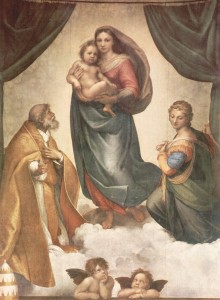I was attracted this morning to an intriguing photograph by Arno Burgi for the EPA showing a workman in Dresden where the “Semper Gallery” is undergoing restoration. The construction worker in hard hat enters a door that seems to lead him through a poster of Raphael’s (1463-1520) painting “The Sistine Madonna.”
Really wonderful, and the painting works on several levels. First, there is the sense of incongruity, of “the sacred and the profane.” But really it is more than that. The

Figure 1 – Raphael’s “Sistine Madonna,” from the Wikimedia Commons, uploaded by the Yorck Project and distributed by DIRECTMEDIA Publishing GmbH and in the public domain because the painting is more than 100 yrs old..
If you know the painting you will recognize that there is a wonderful; element not shown in the poster or the photograph. This is the two cherubs at the bottom of the painting. It is said that they are looking up at the Virgin and child, and at Saint Sixtus and Saint Barbara, also not shown, or perhaps the cherubs are rolling their eyes at my over interpretation. One point ‘though, it has been said that Raphael’s painting is such a masterpiece that upon first seeing it the artist Antonio Da Correggio (1489-1534) was driven to tears and exclaimed, “And I also, I am a painter!”
